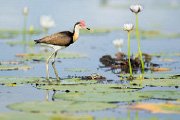Kakadu plum
The Northern Territory’s very own superfood, Kakadu plums are packed with 50 times more vitamin C than oranges.
Kakadu plum trees are common in open tropical woodlands and can be seen from most walking tracks in the park. They are easily recognised by their egg-shaped fruit, large round leaves and spikes of cream-coloured flowers.
One of Kakadu’s few deciduous species, these trees lose their leaves during the dry season. The branches stay bare until they flower in Kurrung (August – October), while the tasty fruits appear towards the end of the tropical summer (March – May).
Culture
Kakadu plums are an important food source for Bininj/Mungguy. The ripe plums are usually eaten raw, although they can also be made into jam.
Bininj/Mungguy use the inner bark of the tree to treat sores and mosquito bites. The red sap can be made into a decorative stain for timber tools.
Commercially grown Kakadu plums are now used to make a range of modern hair, skin and food products.
Common names
- Common names: billygoat plum, green plum
Scientific name
Terminalia ferdinandiana
Take the first step
A journey of 1000 miles begins with a single click.
Enter your email to get free trip planning advice from Kakadu rangers.





